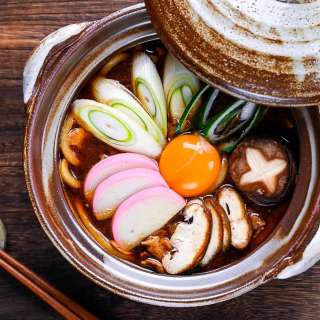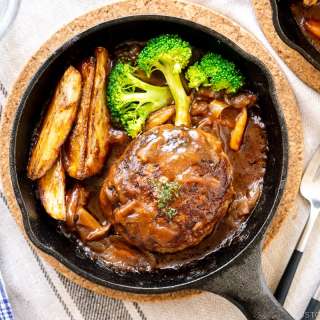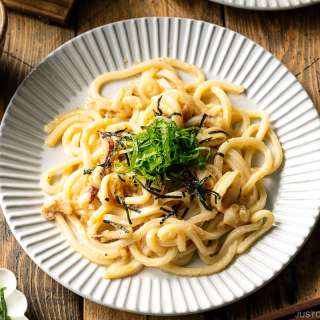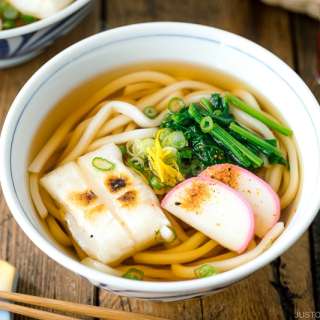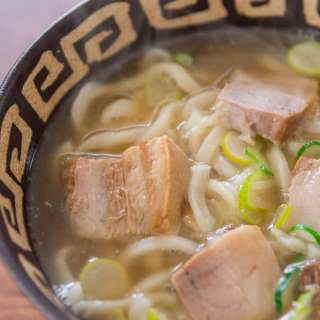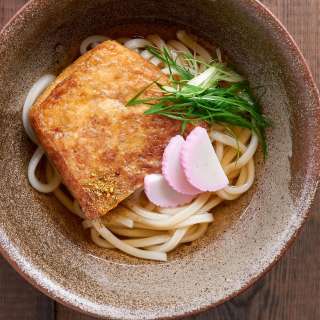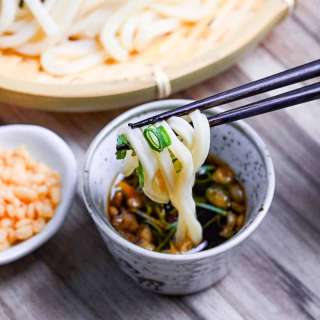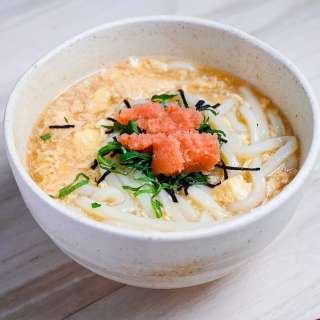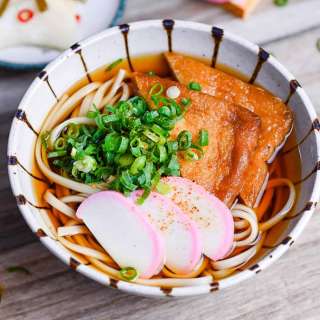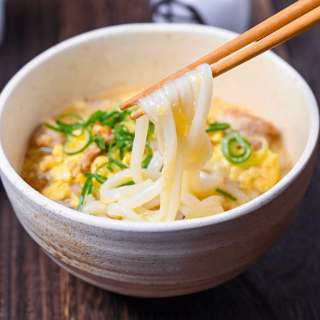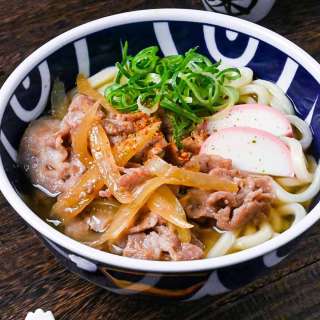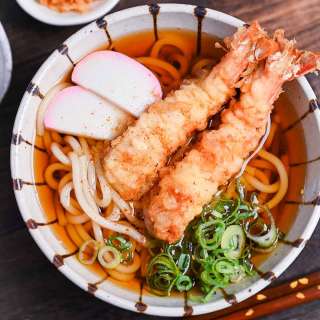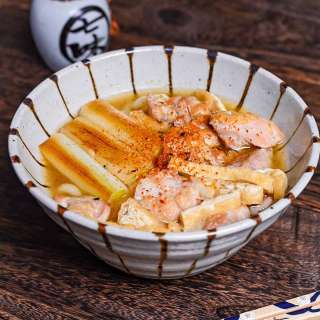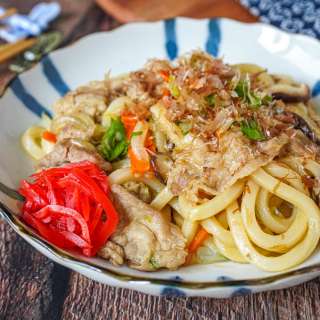
Miso Nikomi Udon
User Reviews
4.9
132 reviews
Excellent
-
Prep Time
15 mins
-
Cook Time
15 mins
-
Total Time
40 mins
-
Servings
2
-
Calories
679 kcal
-
Course
Main Course
-
Cuisine
Japanese

Miso Nikomi Udon
Report
Miso Nikomi Udon is a hearty and comforting noodle soup in which chicken, fish cake, and thick Japanese wheat noodles are simmered in a miso-flavored dashi broth. When it‘s cold outside, this noodle soup will warm you from the inside out.
Share:
Ingredients
- 3 cups dashi (Japanese soup stock) (use standard Awase Dashi, dashi packet or powder, or Vegan Dashi)
- ½ package shimeji mushrooms (1.8 oz, 50 g)
- 4 Shiitake mushrooms (2.3 oz, 65 g)
- ⅓ kamaboko (fish cake)
- 1 Tokyo negi (naga negi; long green onion) (4 oz, 113 g; or use 2 green onions)
- 1 piece aburaage (deep-fried tofu pouch) (or 2 small aburaage pieces)
- 1 chicken thigh (7 oz, 200 g)
- 2 ervings udon noodles (1.1 lb, 500 g frozen or parboiled udon noodles; 6.3 oz, 180 g dry udon noodles)
- 2 large eggs (50 g each w/o shell)
- shichimi togarashi (Japanese seven spice) (for sprinkling)
For the Seasonings
- 3 Tbsp mirin
- 4 Tbsp miso (divided; I used Hikari Miso® Organic Red Miso)
Instructions
- Gather all the ingredients.
Make Dashi
- Make 3 cups dashi (Japanese soup stock) using one of 3 Ways to Make Dashi. Here, I used the convenient dashi packet method. If you want to make dashi from scratch, follow my Awase Dashi recipe. If you’re vegetarian/vegan, use Vegan Dashi.
To Prepare the Ingredients
- Cut the ends of ½ package shimeji mushrooms and separate into smaller clusters.
- Cut the stems of 4 shiitake mushrooms. Cut the caps in half. I use the sogigiri Japanese cutting technique to increase the surface area.
- If you‘d like, you can make a decorative cut called hanagiri on the shiitake caps.
- Cut ⅓ kamaboko (fish cake) into 4 slices.
- Cut 1 Tokyo negi (naga negi; long green onion) diagonally, and separate the white and green parts (we will add them to the pot at different times).
- Pour hot water over 1 piece aburaage (deep-fried tofu pouch) to get rid of the factory oil. Some people skip this step as the oil used is cleaner these days. I do it anyway to get rid of excess oil. Optionally, you can cut it into smaller pieces like triangles.
- Cut 1 chicken thigh into smaller bite-size pieces. I use the sogigiri technique to create a bigger surface area on the chicken so it will cook faster and absorb more flavors.
- Bring a pot of water to a boil. Add 2 servings udon noodles (frozen or parboiled) and loosen them with chopsticks. Once loosened (30 seconds or so), drain the udon noodles into a colander and set aside. If you use dry noodles, follow the package instructions.
- Crack 2 large eggs (50 g each w/o shell) into a small bowl (so you won’t accidentally drop an eggshell into the pot). All the ingredients are now ready to go!
To Cook the Miso Nikomi Udon
- In a large pot or donabe, add the dashi, chicken, and white part of the negi.
- Cover to cook on medium heat for 10 minutes, or until the outside of the chicken is no longer pink (the inside can be still pink at this stage). When it boils, turn the heat down to maintain a simmer. Skim off the fat and scum with a fine-mesh skimmer.
- Add 3 Tbsp mirin and 3 Tbsp miso. (Keep the remaining 1 Tbsp for later. Why? Read my post.) I use a miso muddler that works wonderfully to dissolve the miso completely. You also can place the miso in a ladle with some hot dashi and use cooking chopsticks to dissolve the miso before releasing it to the soup. This ensures that there are no miso chunks left at the bottom of the pot.
- Add the udon noodles, aburaage, shimeji mushrooms, shiitake mushrooms, and green part of the negi. If you care about the presentation of this dish, now is a good time to fish out the chicken and vegeteables and place each ingredient neatly on top of the noodles.
- Increase the heat to medium, cover with the lid, and cook for 5 minutes. Once boiling, turn the heat down to a simmer. Once in a while, check with your cooking chopsticks that the udon or other ingredients are not stucking to the bottom of the pot. Skim off the fat and scum with a fine-mesh skimmer.
- Add the remaining 1 Tbsp miso to the soup. Be careful not to drop in a whole chunk of miso. Use a ladle as a “mixing bowl” to first dissolve the miso in some dashi before adding it to the soup.
- Add the kamaboko fish cakes (where you can display its nice color) and carefully drop the eggs in the middle. From this point, you do not want to cover with the lid (since egg yolk will develop a thin white coating if you cover it). Cook for 2–3 minutes.
To Serve
- Serve the pot at the table. Portion into the individual bowls and sprinkle shichimi togarashi (Japanese seven spice) for a spicy kick.
To Store
- Keep the soup broth and toppings separately in airtight containers and store in the refrigerator for up to 3 days. It‘s best to prepare the udon noodles right before you assemble and serve.
Nutrition Information
Show Details
Calories
679kcal
(34%)
Carbohydrates
72g
(24%)
Protein
36g
(72%)
Fat
23g
(35%)
Saturated Fat
6g
(30%)
Trans Fat
1g
Cholesterol
284mg
(95%)
Sodium
1032mg
(43%)
Potassium
552mg
(16%)
Fiber
8g
(32%)
Sugar
10g
(20%)
Vitamin A
483IU
(10%)
Vitamin C
4mg
(4%)
Calcium
101mg
(10%)
Iron
4mg
(22%)
Nutrition Facts
Serving: 2Serving
Amount Per Serving
Calories 679 kcal
% Daily Value*
| Calories | 679kcal | 34% |
| Carbohydrates | 72g | 24% |
| Protein | 36g | 72% |
| Fat | 23g | 35% |
| Saturated Fat | 6g | 30% |
| Trans Fat | 1g | 50% |
| Cholesterol | 284mg | 95% |
| Sodium | 1032mg | 43% |
| Potassium | 552mg | 12% |
| Fiber | 8g | 32% |
| Sugar | 10g | 20% |
| Vitamin A | 483IU | 10% |
| Vitamin C | 4mg | 4% |
| Calcium | 101mg | 10% |
| Iron | 4mg | 22% |
* Percent Daily Values are based on a 2,000 calorie diet.
Genuine Reviews
User Reviews
Overall Rating
4.9
132 reviews
Excellent
Other Recipes
